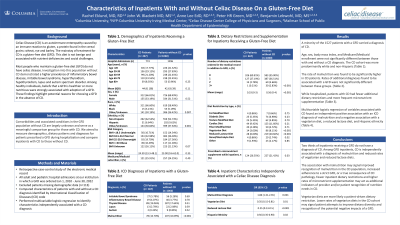Monday Poster Session
Category: Small Intestine
P2639 - Characteristics of Inpatients With and Without Celiac Disease on a Gluten-Free Diet
Monday, October 23, 2023
10:30 AM - 4:15 PM PT
Location: Exhibit Hall

Has Audio

Rachel Eklund, MD, RD
New York-Presbyterian/Columbia University Medical Center
New York, NY
Presenting Author(s)
Rachel Eklund, MD, RD1, John W. Blackett, MD, MS2, Anne R. Lee, EdD, RD2, Peter H.R. Green, MD2, Benjamin Lebwohl, MD, MS2
1New York-Presbyterian/Columbia University Medical Center, New York, NY; 2Columbia University Medical Center, New York, NY
Introduction: Most people who maintain a gluten-free diet (GFD) do not have celiac disease. Comorbidities and associated conditions in this population are largely unknown. We aimed to measure demographics, dietary patterns and diagnoses for patients prescribed a GFD during hospitalization and compare inpatients with celiac disease to those without celiac disease.
Methods: We performed a retrospective case-control study of the electronic medical record for all hospital admissions at our institution in which a GFD was ordered between Jan 1, 2010 and June 30, 2022. We excluded patients missing demographic data (n=113). We compared characteristics of patients with vs without a celiac disease diagnosis. We performed multivariable logistic regression to identify characteristics independently associated with a celiac disease diagnosis.
Results: We analyzed 1527 patients with a GFD. A minority (n= 467, 30.6%) of these patients carried a diagnosis of celiac disease. Age, sex, body mass index and Medicare/Medicaid enrollment were not significantly different between these groups. The celiac cohort was more predominantly white (66.6% vs 58.4%, p=0.007) and non-Hispanic (62.5% vs. 52.7%, p=0.001). Rates of additional diagnoses associated with a GFD (e.g. irritable bowel syndrome) were not significantly different (see table). While hospitalized, patients with celiac disease had fewer additional dietary restrictions (mean 0.33 vs 0.56, p< 0.001) and more frequent micronutrient supplementation (26.6% vs 21.4%, p=0.03). Multivariable logistic regression of variables associated with celiac disease found an independent association with an ICD diagnosis of malnutrition (OR 1.86, 95% CI 1.31-2.65, p=0.001) and an inverse association with a vegetarian diet (OR 0.35, 95% CI 0.15-0.81, p=0.01), a reduced lactose diet (OR 0.25, 95% CI 0.13-0.50, p< 0.001) and Hispanic ethnicity (OR 0.56 95% CI 0.35-0.90, p=0.02) while controlling for other covariates.
Discussion: Two thirds of inpatients receiving a GFD do not have a diagnosis of celiac disease. Among GFD inpatients, celiac disease is independently associated with a diagnosis of malnutrition. This higher rate of malnutrition may signal improved recognition of malnutrition in the celiac disease population. Fewer inpatient dietary restrictions and higher rates of micronutrient supplementation may act as additional indicators of provider recognition of nutrition needs in celiac disease.
Disclosures:
Rachel Eklund, MD, RD1, John W. Blackett, MD, MS2, Anne R. Lee, EdD, RD2, Peter H.R. Green, MD2, Benjamin Lebwohl, MD, MS2. P2639 - Characteristics of Inpatients With and Without Celiac Disease on a Gluten-Free Diet, ACG 2023 Annual Scientific Meeting Abstracts. Vancouver, BC, Canada: American College of Gastroenterology.
1New York-Presbyterian/Columbia University Medical Center, New York, NY; 2Columbia University Medical Center, New York, NY
Introduction: Most people who maintain a gluten-free diet (GFD) do not have celiac disease. Comorbidities and associated conditions in this population are largely unknown. We aimed to measure demographics, dietary patterns and diagnoses for patients prescribed a GFD during hospitalization and compare inpatients with celiac disease to those without celiac disease.
Methods: We performed a retrospective case-control study of the electronic medical record for all hospital admissions at our institution in which a GFD was ordered between Jan 1, 2010 and June 30, 2022. We excluded patients missing demographic data (n=113). We compared characteristics of patients with vs without a celiac disease diagnosis. We performed multivariable logistic regression to identify characteristics independently associated with a celiac disease diagnosis.
Results: We analyzed 1527 patients with a GFD. A minority (n= 467, 30.6%) of these patients carried a diagnosis of celiac disease. Age, sex, body mass index and Medicare/Medicaid enrollment were not significantly different between these groups. The celiac cohort was more predominantly white (66.6% vs 58.4%, p=0.007) and non-Hispanic (62.5% vs. 52.7%, p=0.001). Rates of additional diagnoses associated with a GFD (e.g. irritable bowel syndrome) were not significantly different (see table). While hospitalized, patients with celiac disease had fewer additional dietary restrictions (mean 0.33 vs 0.56, p< 0.001) and more frequent micronutrient supplementation (26.6% vs 21.4%, p=0.03). Multivariable logistic regression of variables associated with celiac disease found an independent association with an ICD diagnosis of malnutrition (OR 1.86, 95% CI 1.31-2.65, p=0.001) and an inverse association with a vegetarian diet (OR 0.35, 95% CI 0.15-0.81, p=0.01), a reduced lactose diet (OR 0.25, 95% CI 0.13-0.50, p< 0.001) and Hispanic ethnicity (OR 0.56 95% CI 0.35-0.90, p=0.02) while controlling for other covariates.
Discussion: Two thirds of inpatients receiving a GFD do not have a diagnosis of celiac disease. Among GFD inpatients, celiac disease is independently associated with a diagnosis of malnutrition. This higher rate of malnutrition may signal improved recognition of malnutrition in the celiac disease population. Fewer inpatient dietary restrictions and higher rates of micronutrient supplementation may act as additional indicators of provider recognition of nutrition needs in celiac disease.
Disclosures:
Rachel Eklund indicated no relevant financial relationships.
John Blackett indicated no relevant financial relationships.
Anne Lee indicated no relevant financial relationships.
Peter H.R. Green: Equillium – Advisory Committee/Board Member. Salvo Health – Advisory Committee/Board Member, Stock Options.
Benjamin Lebwohl indicated no relevant financial relationships.
Rachel Eklund, MD, RD1, John W. Blackett, MD, MS2, Anne R. Lee, EdD, RD2, Peter H.R. Green, MD2, Benjamin Lebwohl, MD, MS2. P2639 - Characteristics of Inpatients With and Without Celiac Disease on a Gluten-Free Diet, ACG 2023 Annual Scientific Meeting Abstracts. Vancouver, BC, Canada: American College of Gastroenterology.
